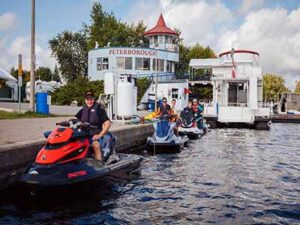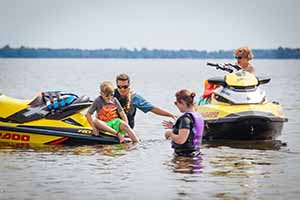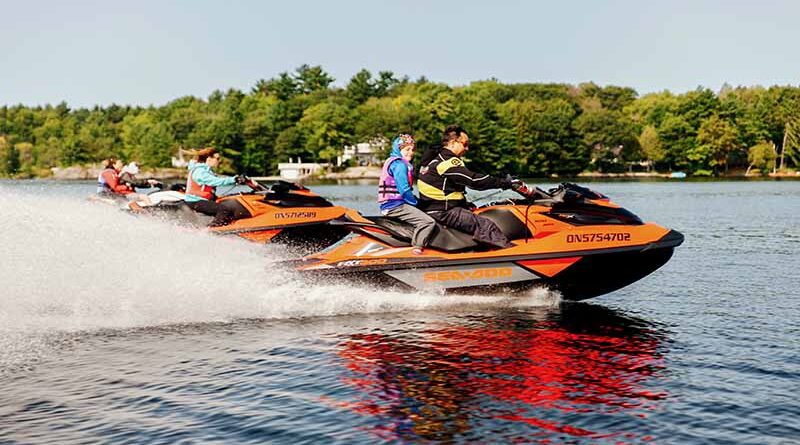10 PWC Myths
By Craig Nicholson
 Despite the increasing popularity of personal watercraft (also called a PWC, jet ski, sea-doo or water scooter), many myths persist about them, especially among those who’ve never driven one (or at least not recently). Some of these misconceptions may have had some partial basis in the past. Some were simply bogus from the get-go. Others derive from poor operator behaviour, giving all PWCs a bad rap. But I’m well-versed at myth-busting, so let’s look at today’s jet ski reality, including some important PWC beginners’ advice…
Despite the increasing popularity of personal watercraft (also called a PWC, jet ski, sea-doo or water scooter), many myths persist about them, especially among those who’ve never driven one (or at least not recently). Some of these misconceptions may have had some partial basis in the past. Some were simply bogus from the get-go. Others derive from poor operator behaviour, giving all PWCs a bad rap. But I’m well-versed at myth-busting, so let’s look at today’s jet ski reality, including some important PWC beginners’ advice…
Myth 1: PWCs Are Toys
Many owners treat their jet skis as toys and impart this misperception to their families and friends. One consequence is irresponsible behaviour, such as annoying the neighbours by doing donuts in front of their cottage, instead of out in the middle of the lake. This “toy” mentality can also lead to the dangerous misconception that PWCs are not boats, subject to the same as boats under Canadian marine regulations.
Another result of treating your jet ski as a toy is that you’re unlikely to appreciate its real potential. Today’s fully featured PWCs are among the most technically advanced vessels on the water. They are perfect for day cruising and multi-day tours, something no mere “toy” can do.
Myth 2: PWCs Are Noisy
Certainly jet ski riding is noisier than canoeing. But in normal cruising operation, PWCs are quieter than ever before. Progressive advances in sound suppression technology have reduced noise levels by over 70% compared to earlier models. Meanwhile, next generation electric engines will make your next PWC as quiet as a canoe.
Myth 3: PWCs Are Wet
Most non-riders often think that riding a personal watercraft is synonymous with getting soaked. Certainly, manufacturers’ promo brochures and videos often reinforce this PWC misconception, but for the most part, getting soaked is your choice. It’s rare for me to get wet on a Sea-Doo tour unless I get caught in the rain.
Myth 4: PWCs Generate Big Wake
Some people perceive PWCs as real tsunami-makers. Compared to most boats, a jet ski’s smaller displacement doesn’t generate large wake. Their underwater jet drive also reduces wake size and duration. Part of the wake misconception results from PWC riders playing too close to shore, but that’s an operator issue, not a design fault.
Myth 5: PWCs Go Anywhere
A jet ski can go many places a larger boat can’t, such as narrow channels and shallower water. But that doesn’t preclude damage from submerged rocks or shoals. Also, weeds, loose stones or debris are more likely to clog your impeller, which can suddenly incapacitate your PWC and even do serious engine damage. So always be very cautious whenever you venture off into in less travelled waters – and since PWCs aren’t with equipped navigation lights, never go anywhere after dark!
Myth 6: Only Swim Suit & PDF
One painful myth is that riders can magically avoid sunburn. Don’t believe it, because riding a jet ski offers no protection from the rays, and unlike in boats, there’s very limited ability to change your riding position. Always use sunscreen, and for longer rides, cover any exposed skin (most affected: hands, arms, shoulders, face & head, thighs and ankles) by wearing protective gear.
Protection will also help avoid painful splats in the face from large flying insects – a great reason never to ride with your mouth open or without eye protection (goggles/sunglasses). It also prevents the painful pinpricks of rain pelting against bare flesh and cuts the chill when zipping along on a breezy summer day.
Myth 7: No Fuel Worries
Water friction drains your PWC fuel tank faster than comparable land-based recreational vehicles. Jet ski fuel mileage also depends on variables such as speed, water condition, head winds and weight of rider(s). So always start with a full tank, know where the closest marina is, and carry extra fuel in a LinQ caddy, because running on empty isn’t fun.
Myth 8: Passengers On Any PWC
Many purpose-built PWC models are available. Some are single seaters, while others are designed for carrying passengers. Single seaters tend to be shorter and narrower, great for solo riding, but tippier with passenger(s) on board. So if you’re planning to do much riding double, everyone will be more comfortable (and safer) on a model that’s factory-equipped with a longer seat, more legroom and a wider hull for greater stability.
Single seaters tend to be shorter and narrower, great for solo riding, but tippier with passenger(s) on board. So if you’re planning to do much riding double, everyone will be more comfortable (and safer) on a model that’s factory-equipped with a longer seat, more legroom and a wider hull for greater stability.
Myth 9: No Need For Storage
Nope. Plenty of secure, dry storage space is essential. From personal items like smart phone, refreshments, towels and extra wearables, to riding necessities like mooring lines, tow rope, bumpers, anchor and emergency gear, it’s better to have more room on board. That’s why I always opt for larger models that have more built-in storage, plus extra room for removable LinQ cargo accessories.
Myth 10: Anyone Can Ride One
Yes, but not without training. PWC’s are easy to ride, especially for those with previous boating experience or who are already familiar with the concepts of handlebar steering, throttle, brake, and the use of body English. But the operative word here is “learn” – jet skis are super quick, nimble and responsive, but rely on engine thrust for the acceleration and deceleration for control to maneuver, stop and operate safely. Mastering this takes practice, so after obtaining your Pleasure Craft Operators License, go slow until you’re 100% comfortable – and always remember: give way to other craft!
Now that we’ve dispelled these 10 myths, enjoy your PWC summer on the water in the Kawarthas – and ride safe!
Craig Nicholson, The Intrepid Cottager, is a long-time Kawarthas cottager who provides tips and tour info for PWC riders at intrepidcottager.com and for snowmobilers at www.intrepidsnowmobiler.com.
Main Photo Credit: Martin Lortz
Top Left & Bottom Right Photo Credit: Allan Glanfield




